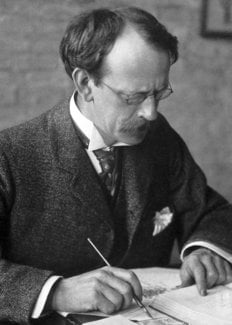J.J. Thomson
Biographical
 Joseph John Thomson was born in Cheetham Hill, a suburb of Manchester on December 18, 1856. He enrolled at Owens College, Manchester, in 1870, and in 1876 entered Trinity College, Cambridge as a minor scholar. He became a Fellow of Trinity College in 1880, when he was Second Wrangler and Second Smith’s Prizeman, and he remained a member of the College for the rest of his life, becoming Lecturer in 1883 and Master in 1918. He was Cavendish Professor of Experimental Physics at Cambridge, where he succeeded Lord Rayleigh, from 1884 to 1918 and Honorary Professor of Physics, Cambridge and Royal Institution, London.
Joseph John Thomson was born in Cheetham Hill, a suburb of Manchester on December 18, 1856. He enrolled at Owens College, Manchester, in 1870, and in 1876 entered Trinity College, Cambridge as a minor scholar. He became a Fellow of Trinity College in 1880, when he was Second Wrangler and Second Smith’s Prizeman, and he remained a member of the College for the rest of his life, becoming Lecturer in 1883 and Master in 1918. He was Cavendish Professor of Experimental Physics at Cambridge, where he succeeded Lord Rayleigh, from 1884 to 1918 and Honorary Professor of Physics, Cambridge and Royal Institution, London.
Thomson’s early interest in atomic structure was reflected in his Treatise on the Motion of Vortex Rings which won him the Adams Prize in 1884. His Application of Dynamics to Physics and Chemistry appeared in 1886, and in 1892 he had his Notes on Recent Researches in Electricity and Magnetism published. This latter work covered results obtained subsequent to the appearance of James Clerk Maxwell’s famous “Treatise” and it is often referred to as “the third volume of Maxwell”. Thomson co-operated with Professor J. H. Poynting in a four-volume textbook of physics, Properties of Matter and in 1895 he produced Elements of the Mathematical Theory of Electricity and Magnetism, the 5th edition of which appeared in 1921.
In 1896, Thomson visited America to give a course of four lectures, which summarised his current researches, at Princeton. These lectures were subsequently published as The Discharge of Electricity through Gases (1898). On his return from America, he achieved the most brilliant work of his life – an original study of cathode rays culminating in the discovery of the electron, which was announced during the course of his evening lecture to the Royal Institution on Friday, April 30, 1897. His book, Conduction of Electricity through Gases, published in 1903 was described by Lord Rayleigh as a review of “Thomson’s great days at the Cavendish Laboratory”. A later edition, written in collaboration with his son, George, appeared in two volumes (1928 and 1933).
Thomson returned to America in 1904 to deliver six lectures on electricity and matter at Yale University. They contained some important suggestions as to the structure of the atom. He discovered a method for separating different kinds of atoms and molecules by the use of positive rays, an idea developed by Aston, Dempster and others towards the discovery of many isotopes. In addition to those just mentioned, he wrote the books, The Structure of Light (1907), The Corpuscular Theory of Matter (1907), Rays of Positive Electricity (1913), The Electron in Chemistry (1923) and his autobiography, Recollections and Reflections (1936), among many other publications.
Thomson, a recipient of the Order of Merit, was knighted in 1908. He was elected Fellow of the Royal Society in 1884 and was President during 1916-1920; he received the Royal and Hughes Medals in 1894 and 1902, and the Copley Medal in 1914. He was awarded the Hodgkins Medal (Smithsonian Institute, Washington) in 1902; the Franklin Medal and Scott Medal (Philadelphia), 1923; the Mascart Medal (Paris), 1927; the Dalton Medal (Manchester), 1931; and the Faraday Medal (Institute of Civil Engineers) in 1938. He was President of the British Association in 1909 (and of Section A in 1896 and 1931) and he held honorary doctorate degrees from the Universities of Oxford, Dublin, London, Victoria, Columbia, Cambridge, Durham, Birmingham, Göttingen, Leeds, Oslo, Sorbonne, Edinburgh, Reading, Princeton, Glasgow, Johns Hopkins, Aberdeen, Athens, Cracow and Philadelphia.
In 1890, he married Rose Elisabeth, daughter of Sir George E. Paget, K.C.B. They had one son, now Sir George Paget Thomson, Emeritus Professor of Physics at London University, who was awarded the Nobel Prize for Physics in 1937, and one daughter.
For more updated biographical information, see: Thomson, Joseph John, Recollections and Reflections. G. Bell and Sons: London, 1936.
J.J. Thomson died on August 30, 1940.
Nobel Prizes and laureates
Six prizes were awarded for achievements that have conferred the greatest benefit to humankind. The 12 laureates' work and discoveries range from proteins' structures and machine learning to fighting for a world free of nuclear weapons.
See them all presented here.
